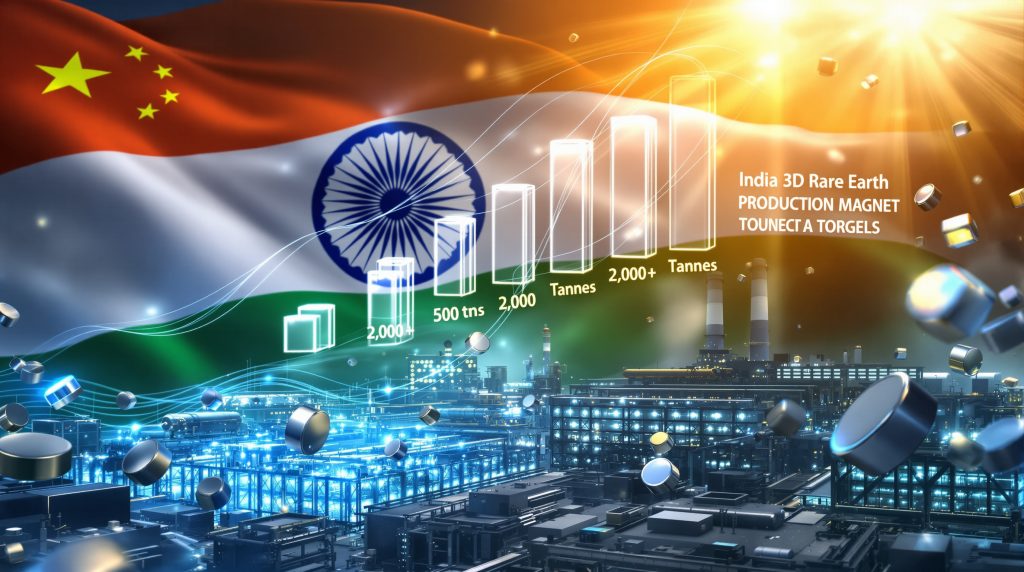Understanding India's Strategic Push for Rare Earth Independence
India's ambitious expansion of its rare earth magnet incentive programme represents a fundamental shift in global critical materials strategy. The government's decision to nearly triple funding from an initial $290 million to approximately $788 million demonstrates unprecedented commitment to establishing domestic manufacturing capabilities in a sector dominated by Chinese producers.
This comprehensive initiative addresses multiple strategic vulnerabilities simultaneously. Beyond simple import substitution, the programme tackles technological dependency, supply chain resilience, and national security considerations that have become increasingly urgent following China's export restrictions implemented in April 2024.
Programme Architecture and Financial Commitments
The expanded incentive structure combines production-linked incentives with capital subsidies, creating a multi-layered support system designed to overcome the fundamental economic challenges that have historically prevented viable rare earth magnet manufacturing outside China. Furthermore, the programme's scope extends beyond simple financial assistance to encompass technology transfer facilitation and comprehensive industry development.
Key Financial Components:
• Initial Phase Investment: $290 million targeting electric vehicles, renewable energy, and defense applications
• Expanded Programme Budget: Rs70 billion (approximately $786-788 million) awaiting cabinet approval
• Target Company Support: Approximately 5 manufacturers in the expanded phase
• Annual Material Requirements: 2,000 tonnes of rare earth oxides annually
The programme's financial structure acknowledges that domestic production of rare earth magnets remains non-viable without substantial government subsidies, according to industry assessments. This recognition drives the comprehensive support approach that addresses both capital-intensive startup costs and ongoing operational challenges.
China's Market Dominance Creates Strategic Vulnerabilities
China's control over approximately 90% of global rare earth processing has created systemic risks across multiple industries. The April 2024 export restrictions disrupted automotive supply chains worldwide, demonstrating how concentrated production can become a strategic weapon in international relations.
The concentration of technological expertise in China presents challenges beyond simple material availability. Moreover, manufacturing high-performance neodymium-iron-boron magnets requires specialized knowledge and equipment that has been developed and refined over decades within Chinese industrial ecosystems.
Export Control Impact on Global Supply Chains
Recent Chinese policy changes have forced automotive manufacturers globally to reassess their sourcing strategies. The restrictions have particularly affected electric vehicle production, where rare earth magnets are essential components for motor efficiency and performance.
India is set to triple rare earth magnet incentives to $788 million amid growing supply chain concerns. This statement reflects growing international consensus that mineral supply security requires geographic diversification of production capabilities.
Current Market Dynamics:
• China has issued first licenses for rare earth magnet imports intended for India
• No licenses have been granted to Indian-origin companies as of November 2025
• Export control easements recently granted to US and EU could potentially extend to India
• Technological expertise remains concentrated in Chinese manufacturing facilities
The geopolitical implications extend beyond commercial considerations, as supply chain dependencies can influence diplomatic relationships and strategic decision-making across multiple policy domains.
Technical Challenges and Capability Development Strategy
Establishing viable rare earth magnet manufacturing requires overcoming significant technical barriers that have historically concentrated production in China. In addition, the process involves complex chemistry, precise material handling, and specialized equipment that demands substantial expertise and capital investment.
Environmental considerations add additional complexity, as rare earth processing involves managing radioactive elements and minimising waste generation. These requirements necessitate advanced processing techniques and environmental management systems that exceed typical manufacturing standards.
Technology Transfer and Knowledge Acquisition
India's approach emphasises partnerships with international technology providers rather than attempting complete indigenous development. This strategy recognises that acquiring proven technologies can accelerate capability development while reducing technical risks, particularly given the current critical minerals strategy being implemented globally.
Technical Development Framework:
• International Technology Partnerships: Collaboration with established magnet manufacturers
• Specialised Training Centres: Development of workforce capabilities for rare earth processing
• Environmental Management: Advanced processing techniques to minimise radioactive waste
• Quality Certification: Implementation of international standards for magnet performance
The government is simultaneously funding research into synchronous reluctance motor technology, which has potential to reduce reliance on rare earth materials entirely. This parallel approach provides strategic flexibility while building current capabilities.
International Partnership Models and Foreign Investment
India's strategy explicitly encourages foreign investment and joint ventures to accelerate technology transfer and market access. This openness contrasts with more protectionist approaches adopted by some countries in critical mineral sectors.
Several overseas suppliers have expressed interest in supplying rare earth materials to India, recognising that the country's expected annual requirement of 2,000 tonnes of rare earth oxides represents manageable demand that global producers can readily supply. This aligns with broader rare earth reserves analysis showing adequate global reserves.
Strategic Advantages for International Partners
India offers several competitive advantages that could attract international rare earth magnet manufacturers. Lower operational costs, established chemical processing expertise, and growing domestic demand from the electric vehicle sector create favourable conditions for manufacturing investment.
Partnership Benefits:
• Market Access: Proximity to rapidly growing Asian electric vehicle and renewable energy markets
• Cost Structure: Lower labour and operational costs compared to Western manufacturing locations
• Government Support: Comprehensive incentive packages including capital and operational subsidies
• Supply Chain Integration: Opportunity to develop complete value chain from oxides to finished products
The programme's requirement for approximately 5 companies suggests targeted development rather than broad industry creation, indicating selective partnership opportunities with substantial government support.
Risk Assessment and Mitigation Strategies
The India rare earth magnet incentive programme faces several implementation challenges that could affect its long-term success. China's potential response through pricing strategies or technology restrictions represents the most significant external risk to programme viability.
If China extends recent export control easements to India, it could undermine the economic viability of domestic production through aggressive pricing strategies. Chinese manufacturers' established cost advantages and technological expertise create competitive pressures that government subsidies must overcome.
Strategic Risk Management
Primary Risk Factors:
• Chinese Competition: Potential for aggressive pricing if export restrictions are eased
• Technology Access: Dependence on foreign partners for critical manufacturing knowledge
• Market Development: Uncertainty about domestic demand growth and timing
• Environmental Compliance: Managing radioactive materials and waste disposal requirements
The programme's phased implementation approach allows for adjustments based on market conditions and competitive responses. Furthermore, this flexibility provides important protection against rapid changes in global supply chain dynamics.
Global Context and Competitive Positioning
India's rare earth magnet initiative represents part of a broader international trend toward supply chain regionalisation in critical materials. The United States, European Union, and Australia have launched similar programmes, creating competitive dynamics for attracting rare earth processing investments.
This development parallels the US executive order on minerals and the European raw materials facility, showing coordinated global efforts to diversify supply chains.
International Comparison Framework
India's geographic positioning provides advantages for serving Asian markets where electric vehicle adoption is accelerating rapidly. The country's established chemical processing industry offers foundation capabilities that can support rare earth magnet manufacturing development.
Competitive Positioning Elements:
• Funding Scale: Substantial financial commitment exceeding many comparable international programmes
• Market Access: Strategic location for serving growing Asian demand for electric vehicle components
• Implementation Timeline: Accelerated development schedule compared to Western initiatives
• Industry Foundation: Existing chemical processing expertise and infrastructure
Success of multiple national programmes could fundamentally alter global rare earth magnet supply chains, potentially reducing China's market share and creating more balanced international production distribution.
Success Metrics and Expected Outcomes
The programme's success will be measured across multiple dimensions beyond simple production targets. Strategic autonomy, technological capability development, and economic impact all represent important outcomes that justify the substantial public investment.
Import substitution represents an immediate measurable benefit, with potential for 60-70% reduction in Chinese rare earth magnet imports if the India rare earth magnet incentive programme achieves its production targets. Consequently, this would significantly enhance supply chain resilience for India's growing electric vehicle and renewable energy sectors.
Long-term Strategic Implications
The programme's broader implications include strengthening India's position across multiple technology sectors that depend on high-performance magnets. Defence equipment, wind turbines, and electric vehicle motors all require reliable access to rare earth magnets for optimal performance.
Expected Performance Indicators:
• Production Capacity: 2,000+ tonnes annual rare earth magnet output by 2030
• Employment Generation: Significant job creation in specialised manufacturing sectors
• Technology Development: Indigenous processing capabilities for advanced magnet grades
• Supply Chain Resilience: Reduced vulnerability to foreign supply disruptions
The programme's success could position India as a significant alternative supplier for countries seeking to diversify their rare earth magnet sources, creating export opportunities alongside domestic supply security.
Future Market Structure and Global Implications
India's entry as a significant rare earth magnet producer could fundamentally alter global supply chain configurations and pricing dynamics. Combined with similar initiatives in other countries, successful implementation could create more balanced international production distribution.
The development of multiple regional production centres would reduce systemic risks associated with concentrated manufacturing and provide countries with alternative sourcing options for critical materials. However, this evolution reflects broader trends toward supply chain regionalisation in strategic industries and mining industry innovation.
Market Evolution Projections
Success of India's programme, along with comparable efforts in other countries, could reduce China's market share from current levels approaching 90% to potentially 60-70% by 2030. According to recent reports, India to triple investment to $788 million in rare earth magnet manufacturing to reduce dependence on Chinese suppliers.
Structural Changes Expected:
• Regional Production Hubs: Development of manufacturing centres in multiple countries
• Technology Diffusion: Gradual spread of rare earth magnet manufacturing expertise globally
• Price Competition: More competitive pricing through increased supply source diversity
• Strategic Balance: Enhanced supply security for major economies and technology sectors
The India rare earth magnet incentive programme represents India's commitment to achieving strategic autonomy in critical materials while contributing to more resilient global supply chains. Success would demonstrate that coordinated government support can overcome established industrial advantages and create new competitive dynamics in strategic sectors.
Disclaimer: This analysis is based on current programme announcements and market conditions. Actual outcomes may vary depending on implementation effectiveness, market responses, and changes in global supply chain dynamics. Investment and policy decisions should consider multiple factors beyond those discussed in this article.
Want to Capitalise on the Rare Earth Boom?
Discovery Alert's proprietary Discovery IQ model delivers instant notifications when ASX-listed rare earth and critical minerals companies announce significant discoveries, helping investors identify actionable opportunities in this rapidly expanding sector. Explore historic examples of exceptional mining discovery returns and begin your 30-day free trial today to position yourself ahead of the market as global demand for critical minerals accelerates.




